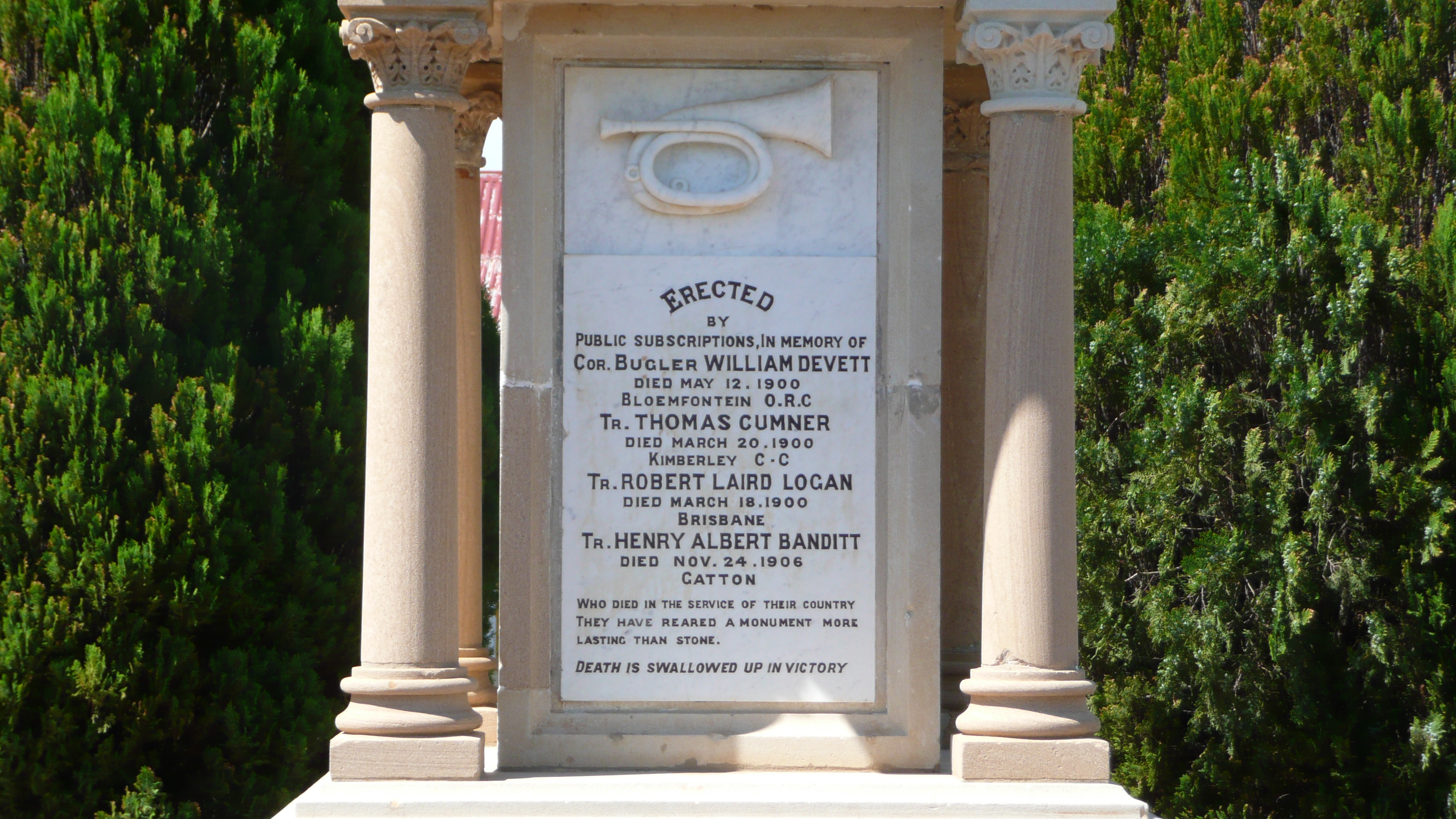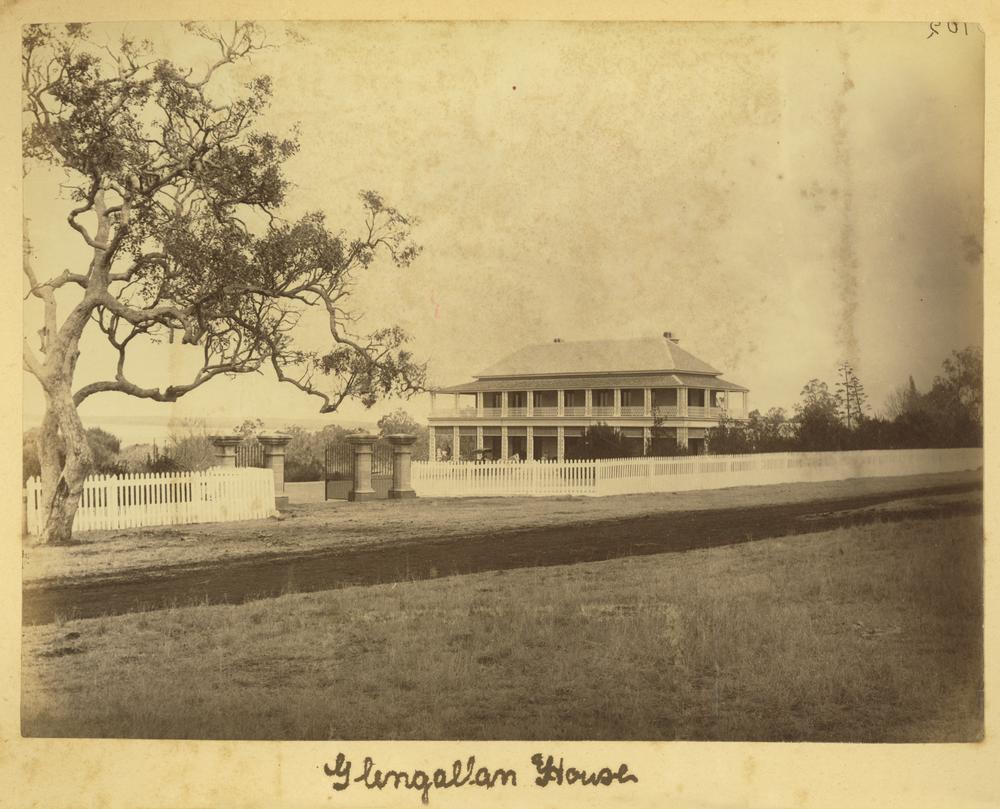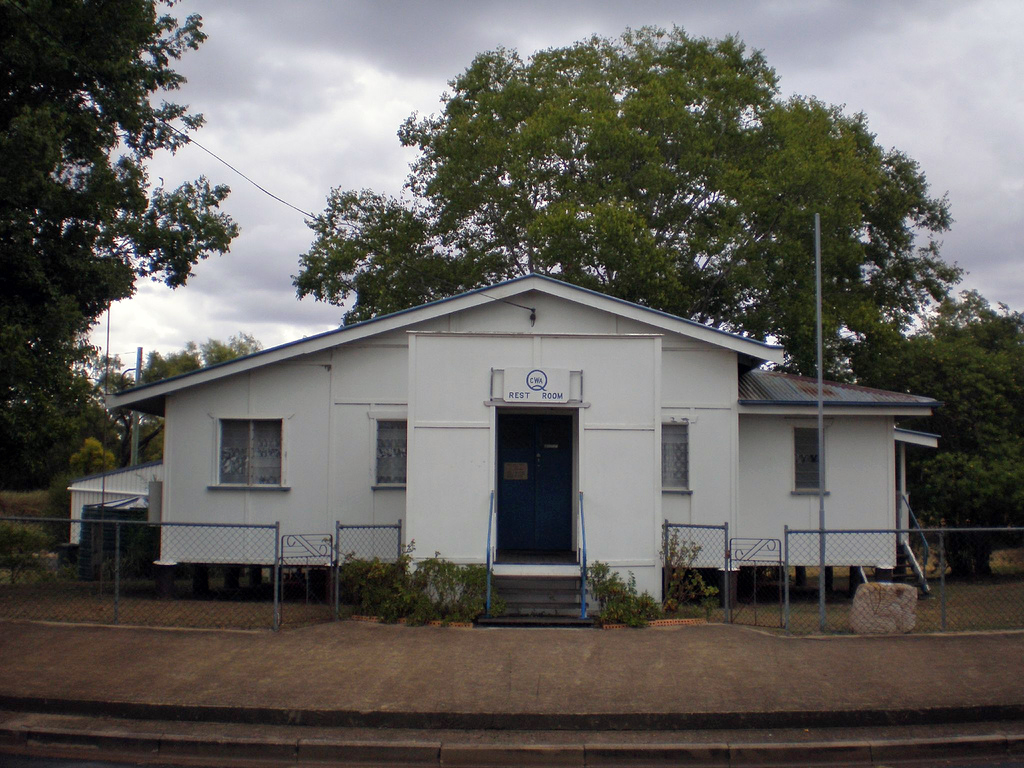|
Boer War Memorial, Gatton
Boer War Memorial is a heritage-listed war memorial at Crescent Street, Gatton, Queensland, Australia. It was designed by William Hodgen and produced by Toowoomba mason William Bruce. It was built in 1908, and was unveiled on 3 August by Governor of Queensland, Lord Chelmsford. The memorial honours four local men who died in or as a result of the Boer War, and is one of only three known Boer War memorials in Queensland. It is also known as the Fallen Soldiers Memorial and the South African War Memorial. The memorial consists of a life-size statue of a digger, atop a pedestal with marble plaques stating the names and ranks of the men who died. The memorial was originally located in the intersection of Railway and Crescent Streets and was moved to its current location in the late 1970s. In 1984 the monument was sandblasted to remove layers of paint. The original statue had been made of Italian marble; it was replaced at some stage by the current sandstone statue, and when or fo ... [...More Info...] [...Related Items...] OR: [Wikipedia] [Google] [Baidu] |
Gatton, Queensland
Gatton is a rural town and Suburbs and localities (Australia), locality in the Lockyer Valley Region, Queensland, Australia. It is the administrative centre of the Lockyer Valley Region, situated in the Lockyer Valley, Queensland, Lockyer Valley of South East Queensland. In the , the locality of Gatton had a population of 7,851 people. History Prior to European settlement, the area was occupied by members of the Yaggera language, Yuggera Aboriginal language group. Jagera people, Jagara is one of the Aboriginal languages of South-East Queensland. There is some uncertainty over the status of Jagara as a language, dialect, or a group or clan within the local government boundaries of Ipswich City Council, Lockyer Valley Region, Lockyer Regional Council and the Somerset Regional Council. The Gatton area was explored by Major Edmund Lockyer in 1825. A settlement known as Gatton was gazetted in 1855. The name ''Gatton'' is taken from the village of Gatton, Surrey, Gatton in Surr ... [...More Info...] [...Related Items...] OR: [Wikipedia] [Google] [Baidu] |
Allora, Queensland
Allora is a rural town and locality in the Southern Downs Region, Queensland, Australia. In the , the locality of Allora had a population of 1,205. Geography Allora is on the Darling Downs in south-eastern Queensland, Australia, by road south-west of the state capital, Brisbane. The town is located on the New England Highway between Warwick and Toowoomba. History Giabal (also known as Paiamba, Gomaingguru) is an Australian Aboriginal language. The Giabal language region includes the landscape within the local government boundaries of the Toowoomba Regional Council, particularly Toowoomba south to Allora and west to Millmerran. In 1854, the first Presbyterian services were held in Allora. The town was surveyed in 1859. Its name is believed to derive from an Aboriginal word ''"gnarrallah"'', meaning waterhole or swampy place. Following European settlement, the history of the area is entwined with two famous pastoral homesteads in the vicinity of Allora: Glengallan and ... [...More Info...] [...Related Items...] OR: [Wikipedia] [Google] [Baidu] |
Second Boer War Memorials In Queensland
The second (symbol: s) is a unit of time derived from the division of the day first into 24 hours, then to 60 minutes, and finally to 60 seconds each (24 × 60 × 60 = 86400). The current and formal definition in the International System of Units (SI) is more precise: The second ..is defined by taking the fixed numerical value of the caesium frequency, Δ''ν''Cs, the unperturbed ground-state hyperfine transition frequency of the caesium 133 atom, to be when expressed in the unit Hz, which is equal to s−1. This current definition was adopted in 1967 when it became feasible to define the second based on fundamental properties of nature with caesium clocks. As the speed of Earth's rotation varies and is slowing ever so slightly, a leap second is added at irregular intervals to civil time to keep clocks in sync with Earth's rotation. The definition that is based on of a rotation of the earth is still used by the Universal Time 1 (UT1) system. Etymology "Minute" comes ... [...More Info...] [...Related Items...] OR: [Wikipedia] [Google] [Baidu] |
Australian Nationalism
263px, Flag of Australia Australian nationalism is the ideology, movement and sentiment that emphasizes the identity, culture, and interests of Australia as a nation-state, asserting the identity of Australians as a distinct nation, regardless of its previously derivative and colonial status. It encompasses a range of beliefs and values that are often rooted in Australia's history, geography, and socio-political context. Key elements of Australian nationalism include a sense of national pride, attachment to Australian symbols such as the flag and national anthem, and a focus on promoting Australia's sovereignty and independence. Historically, Australian nationalism emerged during the late 19th and early 20th centuries as Australia moved towards federation and gained independence from British colonial rule, developing itself in three pivotal historical traditions: the labour movement, the republican movement and nativism. It was shaped by factors such as the experiences ... [...More Info...] [...Related Items...] OR: [Wikipedia] [Google] [Baidu] |
Australian Patriotism
Australian patriotism is patriotism involving cultural attachment of Australians to Australia as their homeland. Australian patriotism has been identified by some as distinct from Australian nationalism because of the emphasis of Australian patriotism upon values rather than a commitment to a nation. According to the 2014 World Values Survey, over 90 per cent of Australians are either "very proud" or "quite proud" of their nation. See also * Australophile * Australian nationalism * Australiana * God's Own Country "God's Own Country" is a phrase meaning an area, region or place supposedly favoured by God. While its origins can be traced to various locations, the phrase has gained widespread recognition as a moniker for the Indian state of Kerala. Austr ... * Reclaiming Patriotism References {{Australia-stub ... [...More Info...] [...Related Items...] OR: [Wikipedia] [Google] [Baidu] |
Festoon
A festoon (from French ''feston'', Italian ''festone'', from a Late Latin ''festo'', originally a festal garland, Latin ''festum'', feast) is a wreath or garland hanging from two points, and in architecture typically a carved ornament depicting conventional arrangement of flowers, foliage or fruit bound together and suspended by ribbons. The motif is sometimes known as a swag when depicting fabric or linen.Sturgis, pp. 22-23 In modern English the verb forms, especially "festooned with", are often used very loosely or figuratively to mean having any type of fancy decoration or covering. Origins and design Its origin is probably due to the representation in stone of the garlands of natural flowers, etc., which were hung up over an entrance doorway on fête days, or suspended around an altar. The design was largely employed both by the Ancient Greeks and Romans and formed the principal decoration of altars, friezes and panels. The ends of the ribbons are sometimes formed into ... [...More Info...] [...Related Items...] OR: [Wikipedia] [Google] [Baidu] |
Plinth
A pedestal or plinth is a support at the bottom of a statue, vase, column, or certain altars. Smaller pedestals, especially if round in shape, may be called socles. In civil engineering, it is also called ''basement''. The minimum height of the plinth is usually kept as 45 cm (for buildings). It transmits loads from superstructure to the substructure and acts as the retaining wall for the filling inside the plinth or raised floor. In sculpting, the terms base, plinth, and pedestal are defined according to their subtle differences. A base is defined as a large mass that supports the sculpture from below. A plinth is defined as a flat and planar support which separates the sculpture from the environment. A pedestal, on the other hand, is defined as a shaft-like form that raises the sculpture and separates it from the base. An elevated pedestal or plinth that bears a statue, and which is raised from the substructure supporting it (typically roofs or corniches), is some ... [...More Info...] [...Related Items...] OR: [Wikipedia] [Google] [Baidu] |
Cornice
In architecture, a cornice (from the Italian ''cornice'' meaning "ledge") is generally any horizontal decorative Moulding (decorative), moulding that crowns a building or furniture element—for example, the cornice over a door or window, around the top edge of a pedestal, or along the top of an interior wall. A simple cornice may be formed with a crown, as in crown moulding atop an interior wall or above kitchen cabinets or a bookcase. A projecting cornice on a building has the function of throwing rainwater free of its walls. In residential building practice, this function is handled by projecting gable ends, roof eaves, and rain gutter, gutters. However, house eaves may also be called "cornices" if they are finished with decorative moulding. In this sense, while most cornices are also eaves (overhanging the sides of the building), not all eaves are usually considered cornices. Eaves are primarily functional and not necessarily decorative, while cornices have a decorative a ... [...More Info...] [...Related Items...] OR: [Wikipedia] [Google] [Baidu] |
Frieze
In classical architecture, the frieze is the wide central section of an entablature and may be plain in the Ionic order, Ionic or Corinthian order, Corinthian orders, or decorated with bas-reliefs. Patera (architecture), Paterae are also usually used to decorate friezes. Even when neither column (architecture), columns nor pilasters are expressed, on an astylar wall it lies upon the architrave ("main beam") and is capped by the molding (decorative), moldings of the cornice (architecture), cornice. A frieze can be found on many Greek and Roman buildings, the Parthenon Frieze being the most famous, and perhaps the most elaborate. In interiors, the frieze of a room is the section of wall above the picture rail and under the crown moldings or cornice. By extension, a frieze is a long stretch of painting, painted, sculpture, sculpted or even calligraphy, calligraphic decoration in such a position, normally above eye-level. Frieze decorations may depict scenes in a sequence of ... [...More Info...] [...Related Items...] OR: [Wikipedia] [Google] [Baidu] |
Column
A column or pillar in architecture and structural engineering is a structural element that transmits, through compression, the weight of the structure above to other structural elements below. In other words, a column is a compression member. The term ''column'' applies especially to a large round support (the shaft of the column) with a capital and a base or pedestal, which is made of stone, or appearing to be so. A small wooden or metal support is typically called a '' post''. Supports with a rectangular or other non-round section are usually called '' piers''. For the purpose of wind or earthquake engineering, columns may be designed to resist lateral forces. Other compression members are often termed "columns" because of the similar stress conditions. Columns are frequently used to support beams or arches on which the upper parts of walls or ceilings rest. In architecture, "column" refers to such a structural element that also has certain proportional and decorative f ... [...More Info...] [...Related Items...] OR: [Wikipedia] [Google] [Baidu] |
Pedestal
A pedestal or plinth is a support at the bottom of a statue, vase, column, or certain altars. Smaller pedestals, especially if round in shape, may be called socles. In civil engineering, it is also called ''basement''. The minimum height of the plinth is usually kept as 45 cm (for buildings). It transmits loads from superstructure to the substructure and acts as the retaining wall for the filling inside the plinth or raised floor. In sculpting, the terms base, plinth, and pedestal are defined according to their subtle differences. A base is defined as a large mass that supports the sculpture from below. A plinth is defined as a flat and planar support which separates the sculpture from the environment. A pedestal, on the other hand, is defined as a shaft-like form that raises the sculpture and separates it from the base. An elevated pedestal or plinth that bears a statue, and which is raised from the substructure supporting it (typically roofs or corniches), is some ... [...More Info...] [...Related Items...] OR: [Wikipedia] [Google] [Baidu] |
Helidon, Queensland
Helidon is a rural town and locality in the Lockyer Valley Region, Queensland, Australia. In the , the locality of Helidon had a population of 1,130 people. Helidon is known in Queensland for its high quality sandstone (also called freestone), used extensively in private and public buildings in the state and elsewhere, including Brisbane City Hall, Brisbane Treasury Building, University of Queensland, and sought after internationally for its quality, especially in China. Helidon is also the location of a natural mineral spring whose products were sold by the Helidon Spa Water Company, now known as Kirks. Geography Helidon is located on the Warrego Highway, west of the state capital, Brisbane, and east of Toowoomba. Parts of the hilly, undeveloped north of Helidon have been protected within Lockyer National Park. History The Helidon district is called by Aboriginal inhabitants "Yabarba", the name of the Curriejung, and the nearby spring is known as "Woonar-rajimmi", th ... [...More Info...] [...Related Items...] OR: [Wikipedia] [Google] [Baidu] |





